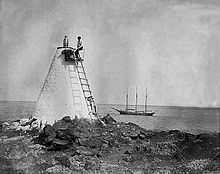Mahukona, Hawaii

Original Māhukona light, 1904
|
|
|
Hawaii
|
|
| Coordinates | 20°10′49.3″N 155°54′05.4″W / 20.180361°N 155.901500°W |
|---|---|
| Year first constructed | 1899 (first) |
| Year first lit | 1915 (current) |
| Deactivated | 1915 (first) |
| Construction | masonry tower (first) reinforced concrete (current) |
| Tower shape | conical frustum tower (first) square pyramidal tower with balcony and light |
| Markings / pattern | white tower |
| Height | 22 metres (72 ft) |
| Focal height | 64 metres (210 ft) |
| Light source | solar power |
| Range | 6 nautical miles (11 km; 6.9 mi) |
| Characteristic | Fl W 4s. |
| Admiralty number | G7226 |
| ARLHS number | HAW-012 |
| USCG number | 28325 |
| Managing agent | United States Coast Guard |
Māhukona is a former settlement on the island of Hawaiʻi. The extinct submerged volcano Māhukona, off shore and to the south, is named for this area. The settlement was once the terminus of the Hawaiian Railroad.
Māhukona was a traditional land division (ahupuaʻa) that extended from a bay to the slopes of Kohala mountain. Much was owned by Princess Ruth Keʻelikōlani at one time. The name means "false harbor" in the Hawaiian language.Lapakahi State Historical Park is just to the south. The harbor is located at 20°11′1″N 155°54′2″W / 20.18361°N 155.90056°WCoordinates: 20°11′1″N 155°54′2″W / 20.18361°N 155.90056°W just off of Akoni Pule Highway, Hawaii Route 270.
While Samuel Garner Wilder was minister of the interior, he secured a charter for a railroad company in 1880. The first sugarcane plantation in the Kohala district was started by Elias Bond in 1863, but transportation proved difficult. Wilder's idea was to transport sugarcane from sugarcane plantations on the wet windward side of Kohala to Māhukona where ships could land. Wilder already ran a steamship company, so built a pier at the Māhukona harbor. Samuel Parker planned a railroad from the east coast to the port of Hilo, but was unable to fund the project. Work was begun in 1881, the first track opened in 1882, and by 1883 had reached about 20 miles (32 km) to the plantation at Niuliʻi, 20°13′23″N 155°44′48″W / 20.22306°N 155.74667°W. There it met the barrier of Pololu Valley.
...
Wikipedia

